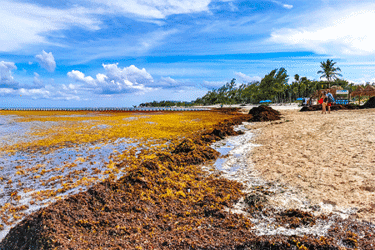5,000-Mile-Wide Seaweed Bloom Approaching Florida, Threatening Water Quality


A downright monstrous source water growth is making its way toward the Florida coast, serving as an unmissable reminder of how climate change is impacting our environment.
“Marine scientists are tracking a 5,000-mile-wide seaweed bloom that is so large, it can be seen from space,” The Hill reported. “At last check, it was heading toward Florida’s Gulf coast … [And] it can also wreak havoc when it gets closer to shore. It blocks light from reaching coral and negatively impacts air and water quality as it decomposes.”
The seaweed, known as sargassum, can tangle up boats and other marine machinery, release dangerous hydrogen sulfide, and inundate beaches. Research suggests the causes for this massive bloom are similar to those that have been driving increases in source water algal bloom, which threatens drinking water quality, across the country.
“Scientists have found that climate change is causing ocean temperatures to rise, creating a more ideal environment for the algae to thrive,” according to The Hill. “Meanwhile, urban and agriculture runoff is sending nitrates from fertilizers and other nutrients flowing into the ocean, feeding the bloom.”
While the U.S. EPA seeks to implement stricter regulations around wastewater practices that can contribute nutrients and lead to growth in source water, directly addressing blooms that already exist is a different challenge. In this way, sargassum has posed some drinking water contamination challenges as well.
“A more basic problem … is how to dispose of this contaminated biomass,” per The Guardian. “Some have suggested using it as a fertiliser, but the heavy metals it contains — particularly arsenic — make it dangerous to feed to plants. Composting, too, could allow the arsenic to leach into groundwater, then drinking water and the food chain … As for industrial uses, removing the heavy metals requires so much processing that it is not cost-effective.”
While the rising scourge of toxic algal may be a threat unique to drinking water and wastewater systems, it will be harder for the general public to ignore this latest bloom as it reaches Florida. It is, after all, a warning that you can see from space.
To read more about how wastewater treatment operations work to reduce algal bloom, visit Water Online’s Nutrient Removal Solutions Center.
